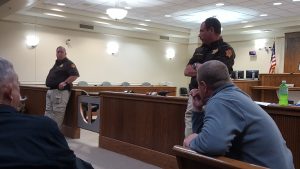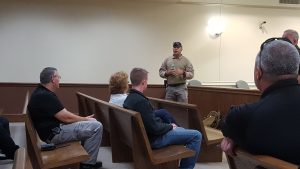
Local first responders and staff with the Marshall County Health Department have taken steps to prepare for an emergency active shooter situation should it happen in the county.
Participants on Oct. 20 held an active shooter training exercise, in which participants from agencies throughout Marshall and McCracken counties, as well as KSP, held a simulated crisis situation. In this particular exercise, assailants planted explosives around the health department and took staff hostage, placing more devices inside and firing shots in the facility.
Responders worked through the steps to defuse the situation, with fellow responders tapped to play the role of assailants. Participants then met after the simulation was complete in a post-action assessment meeting to dissect key components of the exercise and response, as well as identify strengths and weaknesses exposed during the simulation.
The two-hour simulation, a condensed time-frame from a real-life response situation, was an overall success, Marshall County Sheriff’s Deputy Maj. David Maddox said. Still, responders identified areas that needed to be fine-tuned when dealing with a multi-agency response effort. Communication, Maddox said, was an area that could use work.
“Every time that I’ve ever been involved in any kind of exercise that’s always the problem is communications,” Maddox said. “Things sometimes don’t work the way you plan for them to, and that was the case here. But, this gives us the opportunity to look at things like, ‘well Paducah operates on 900 megahertz, we operate on VHF band.’ So, we’ve got some things we need to work on to prepare for an event like this.”
The event highlighted a push toward a more regional effort in response to certain situations. Some participants, in the post-action meeting, brought up the possibility in forming a regional task force to increase frequency of training at that level. Still, it’s a matter of getting the moving pieces to fall in line, which Sheriff Kevin Byars said isn’t always as easy as it sounds.

“That’s something that myself and the other agency heads need to sit down and discuss,” Byars said. “There’s pros and cons to that as well, but it doesn’t hurt to sit down and listen. … It’s just kind of an idea to throw out there, let’s just see what may come of it. As always, the time factor – getting us and the other agencies together to be able to sit down … just coordinate – that’s the hard part. But it’s worth listening to, because you can share resources that way, which we do anyway, but still it would maybe refine it a little bit. It’s worth listening and talking about.”
Agencies do train across county lines, Maddox said. Marshall and McCracken counties and Paducah frequently work in conjunction in everyday response and investigation, Maddox said.
“Their bomb squad works with us, because we don’t have one here,” he said. “The SWAT teams all work together and so do investigation … We try to get together and train so that when we respond to an incident, whether it’s here or Paducah or wherever, we’re prepared to work with those agencies.
“It threw a lot at them, but they still responded really well,” Maddox added. “The big thing is we want to make sure we get all of the resources that we really have available to them so that we can kind of exercise that and coordinate with these other agencies.”
Byars said the agencies try to plan multi-agency simulations about every two to three years when possible. The intensive coordination it takes among agencies to participate and planning of the simulation scenario itself prohibits responders from doing so more frequently, he said.
“You want to make it as realistic as possible,” Byars said. “I didn’t know anything, as far as any details … and that was by design. Because if it’s a real scenario, I shouldn’t know what’s going on. And that’s when myself and (Benton) Chief (Jeromy) Hicks have to make decisions based on what information we’re getting in. And again, that’s where communication is so imperative. … I would hope that our citizens here, McCracken, Calloway, wherever, that they know that we are preparing. Do we think that what’s happened in other places is going to happen here? No, but it can. This is as close to Mayberry as you’re going to get, but we still have issues and things come up. The way the world is going today, it does not hurt to be prepared for the unexpected, and that’s what we try to do.”
It was a learning experience for those not typically on the side of potential danger as well. Marshall County Health Department Public Health Director Laura Hawes-Hammons said she felt the experience was valuable for her staff.

“We got to go through something that hopefully never happens, but if it does at least we’ve had a little exposure to it,” Hawes-Hammons said. “We know what to listen for; you know, those are things a lot of us never hear, gunshots and explosions. So, now we know at least if you hear something like that, don’t just assume it’s nothing. Take some kind of action.”
She said staff got to exercise the department’s emergency plan in an active shooter scenario, as well as work directly with law enforcement to see what a response of that nature would play out. Hawes-Hammons said it gave staff a beneficial insight into the process.
The Health Department approached local law enforcement to consider hosting the exercise about a year ago, following a workplace shooting at a California health department.
“When that happened, I had just started here … and I said, ‘You know, that’s just a little too close to home,’” Hawes-Hammons said. “I mean that’s your business, so it just kind of hit home and I thought we need to be prepared.”
